Link dynamics accessment in low-power wireless networks
Introduction
Interference and link dynamics constitute great concerns for the stability and performance of wireless sensor network protocols. These phenomena normally manifest in link burstiness, i.e, prolonged periods of time where packet transmissions from a sender to a receiver are lost (Srinivasan et al., 2008). Such spikes of packet losses cause delays and instability in communication protocols with potentially severe consequences
Multichannel communication has been proposed as alternative to adaptive (single-channel) routing protocols for mitigating the impact of interference and link dynamics in wireless sensor networks. While several studies have advocated features of both techniques (not without running up against contradicting arguments) a comprehensive study that aligns these results is still lacking. This work aims at filling this gap.
Testbed
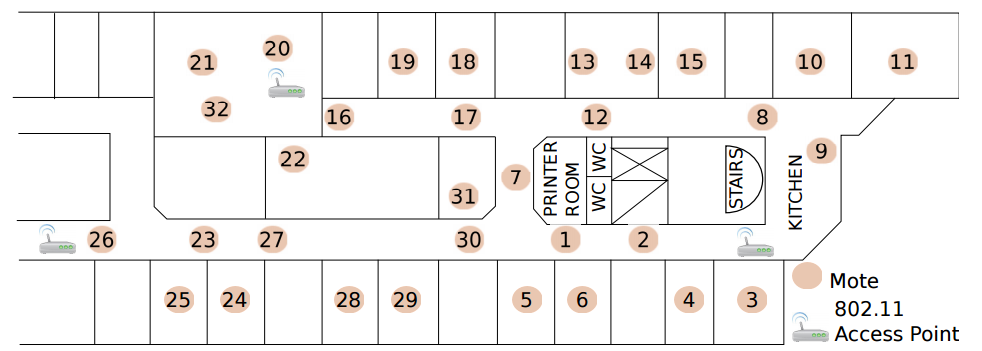 |
Our testbed deployment consisting of 32 nodes. Three WiFi access points per floor, microwave ovens, and people moving in and in-between offices create different types of interference. |
Experiment Overview
 |
Our analysis is based on three sets of experiments, leading to a total of more than 240 hours of experiments and 90 Million transmissions. |
 |
Multi Channel Experiments: Based on industry standards, we select hopping sequences with large inter-channel gaps. |
RF characteristics for point-to-point communications
We compare single channel communication and channel hopping in four settings: (i) packet reception ratio (PRR), (ii) maximum burst loss, (iii) temporal correlation of losses (link burstiness), and (iv) frequency correlation of losses.
1. Packet reception ratio
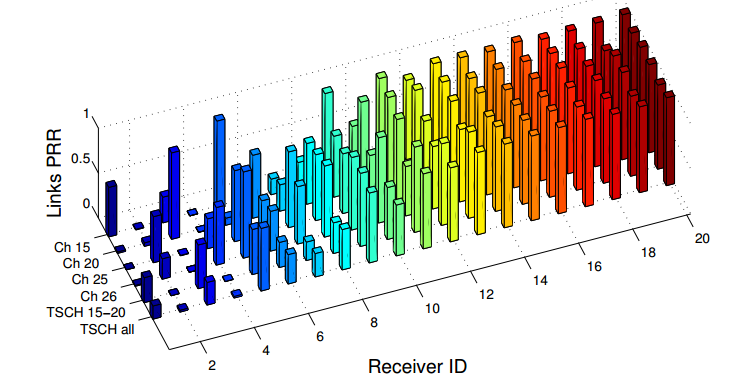 |
Average links PRR for links in the network over the channels c15, c20,
c25 and c26, and for the hopping sequences |
Observation: Our conclusion are aligned with previous results in (Ortiz and Culler, 2010, Sexton et al., 2005) (i.e. the link quality is not homogenous across channels). However, the sole links PRR analysis, as used in (Ortiz and Culler, 2010, Sexton et al., 2005), is not sufficient to characterize the statistical behavior of a packet losses of a multi-channel channel hopping MAC. To close this gap, we next analyze three alternative metrics.
2. Maximum burst loss
Packet losses are often correlated in time and occur in bursts.Therefore, analyzing only the (long term average) packet reception ratio is not sufficient, as it hides important performance indicator such as link burstiness. A simple metric to describe the link RF characteristics in terms of burstiness is the maximum burst loss, defined as the maximum number of consecutive packets lost over a communication link.
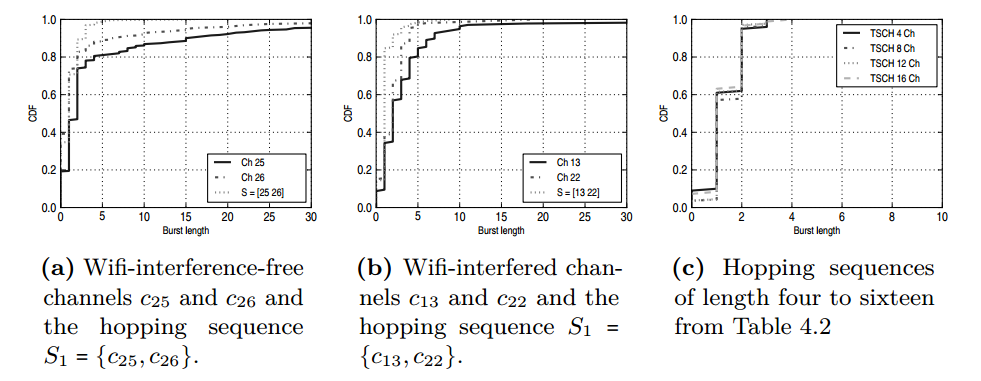 |
Cumulative distribution functions (CDFs) of the maximum burst length for single- and multi-channel communication for three relevant scenarios. |
3. Link burstiness: temporal correlation
To quantify the correlation of packet losses in time for single-channel communication,
Srinivasan et al. defined a “link burstiness” metric referred to as the  -factor (Srinivasan
et al., 2008). The metric is based on the conditional packet delivery function,
C(n), which describes the conditional probability of successful packet reception
given that the n previous packet were received (for
-factor (Srinivasan
et al., 2008). The metric is based on the conditional packet delivery function,
C(n), which describes the conditional probability of successful packet reception
given that the n previous packet were received (for  ) or lost (for
) or lost (for  )
)

where  is the distance from the ideal bursty link, while
is the distance from the ideal bursty link, while  and
and  are the conditional packet delivery
functions of the empirical and independent link with the same PRR, respectively.
are the conditional packet delivery
functions of the empirical and independent link with the same PRR, respectively.
A value of  identifies a link with independent packet losses i.e. following a Bernoulli process,
while a value of
identifies a link with independent packet losses i.e. following a Bernoulli process,
while a value of  indicates a bimodal link, i.e. a link that exists either in a
good or a bad state.
indicates a bimodal link, i.e. a link that exists either in a
good or a bad state.
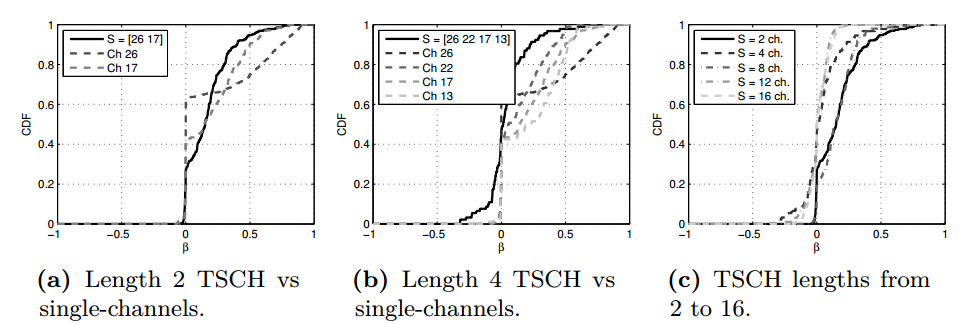 |
Study of the packet loss characteristics with single-channel and multichannel
point-to-point communication by the analysis of the |
Observation: we use  to quantify the temporal correlation of packet losses for both singlechannel
and multi-channel communication. To compute
to quantify the temporal correlation of packet losses for both singlechannel
and multi-channel communication. To compute  in the case of channel
hopping, we consider the sequence of packets received between each transmitterreceiver
pair. Thus, in this case
in the case of channel
hopping, we consider the sequence of packets received between each transmitterreceiver
pair. Thus, in this case  describes the link-burstiness of a given transmitterreceiver
pair across multiple channels and for a given channel hopping sequence.
Both the length of the hopping sequence and the channel used will influence
describes the link-burstiness of a given transmitterreceiver
pair across multiple channels and for a given channel hopping sequence.
Both the length of the hopping sequence and the channel used will influence  .
.
4. Correlation of losses: frequency correlation
We use the metric  -factor (Srinivasan et al., 2010), to describe the inter-link reception correlation in case of single-channel
communication. This metric quantifies the spatial correlation of
packet reception at different nodes receiving packets from the same source.
-factor (Srinivasan et al., 2010), to describe the inter-link reception correlation in case of single-channel
communication. This metric quantifies the spatial correlation of
packet reception at different nodes receiving packets from the same source.
We adapt the theoretical framework of (Srinivasan et al., 2010) to characterize the inter-frequency reception correlation of a link in case of multi-channel communication.
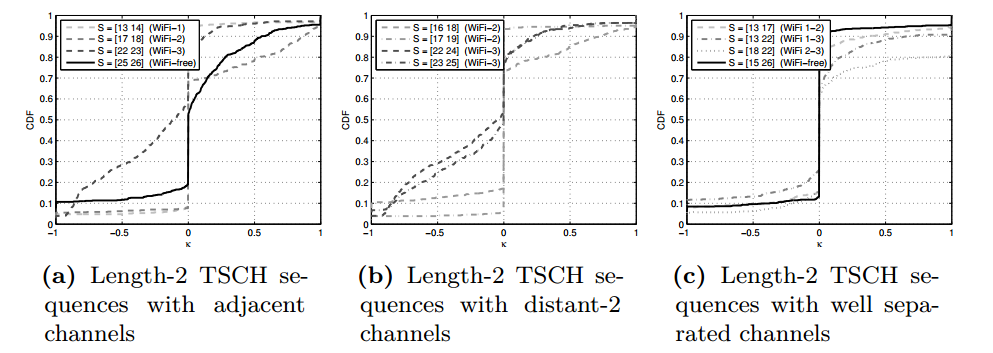 |
Analysis of inter-frequency correlation through the CDF of the  -factor
for length-2 TSCH sequences computed over all links in the network. We consider three
cases: (a) adjacent 802.15.4 channels under different 802.11 channels; (b) distant-2
802.15.4 channels under different 802.11 channels; and (c) well separated 802.15.4
channels.
-factor
for length-2 TSCH sequences computed over all links in the network. We consider three
cases: (a) adjacent 802.15.4 channels under different 802.11 channels; (b) distant-2
802.15.4 channels under different 802.11 channels; and (c) well separated 802.15.4
channels.
Adaptive routing and channel-hopping in multi-hop networks
In this section we evaluate the benefit of channel hopping in multi-hop single-path routing, and present two core findings:
We show that in dense and medium dense networks, channel hopping achieves similar end-to-end performance, such as average delay and reliability, as singlechannel when the channels have roughly the same quality.
In sparse topologies channel hopping can outperform single-channel communication.
1. Routing: channel-hopping in multi-hop networks
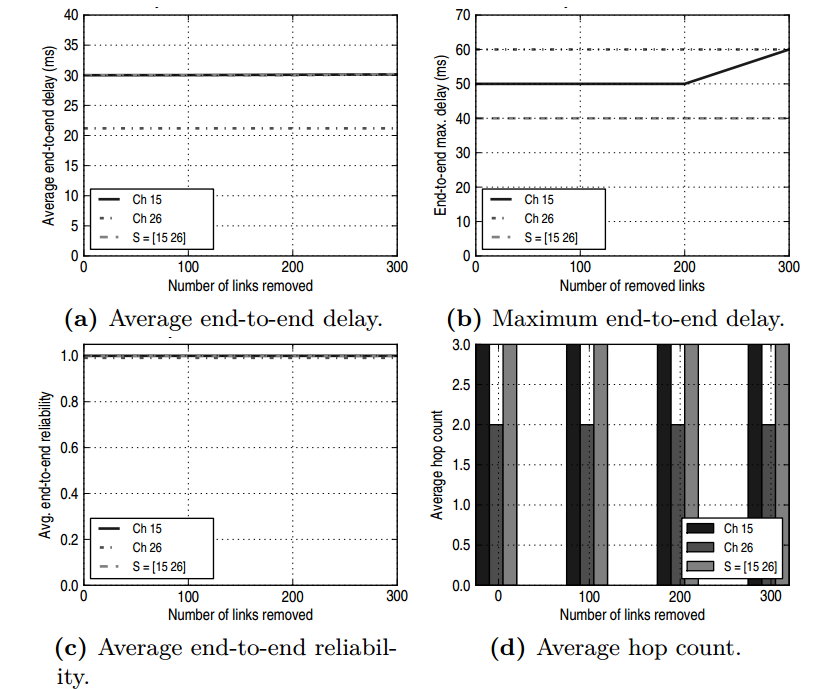 |
Observation: increasing channel robustness does not guarantee a better network performance compared to single channel solution. As long as there still exist many good links in the network, routing makes the use of channel hopping superfluous.
2. Multi-hop analysis in sparse networks
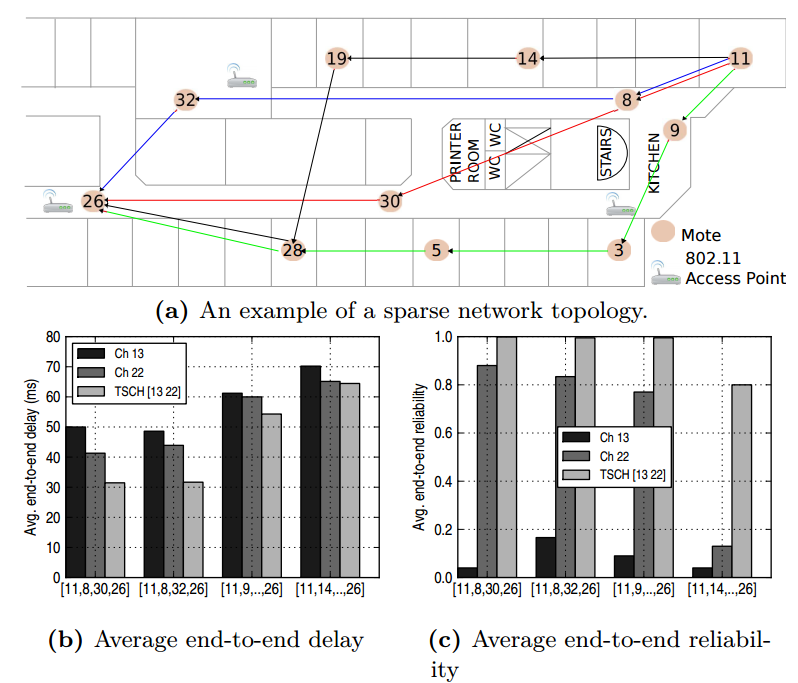 |
comparison between single-channel and TSCH in a sparse network. Channel hopping outperforms single-channel in both the average end-to-end delay, and reliability. |
 and
and  .
.